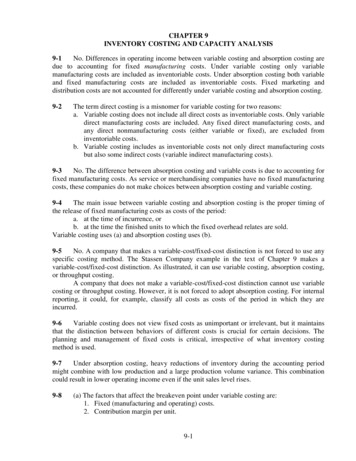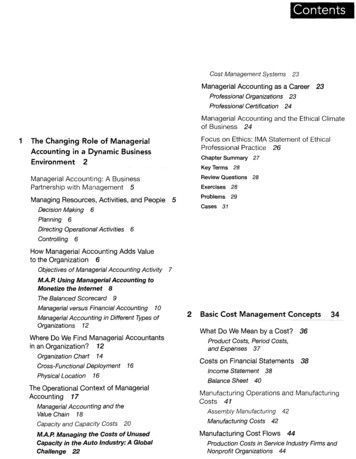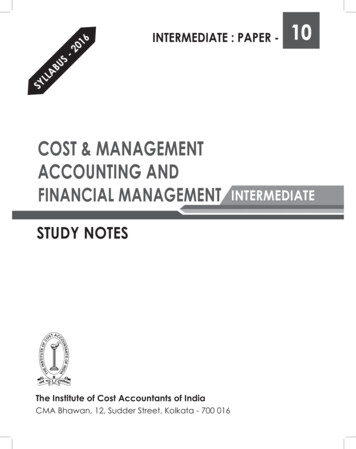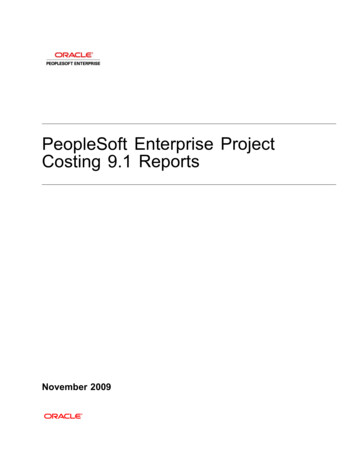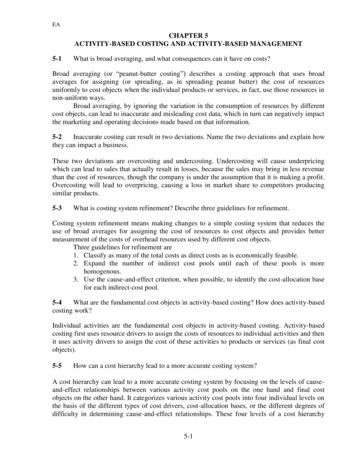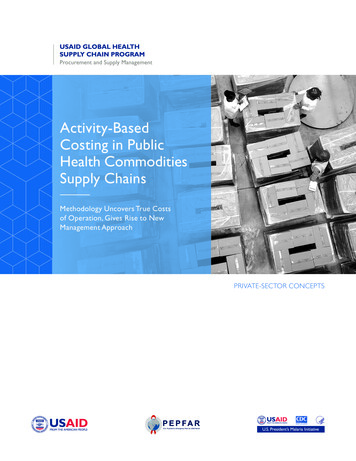
Transcription
Activity-BasedCosting in PublicHealth CommoditiesSupply ChainsMethodology Uncovers True Costsof Operation, Gives Rise to NewManagement ApproachPRIVATE-SECTOR CONCEPTS
Table of ContentsAcknowledgments .3Acronyms .3Executive Summary .4ABC Background .5ABC Implementation .7ABC Management .10Lesotho Case Study .12Conclusion .16Appendices .17ghsupplychain.org@ghsupplychainThe views expressed in this publication do not necessarily reflect the views of theU.S. Agency for International Development or the U.S. government.PHOTO CREDIT (Cover): Mickael Breard USAID GHSC-PSMPHOTO CREDIT (This Page): Andi Gultom
AcknowledgementsThe USAID Global Health Supply Chain Program-Procurement and Supply Management (GHSC-PSM) project is funded under USAIDContract No. AID-OAA-I-15-0004. GHSC-PSM connects technical solutions and proven commercial processes to promote efficientand cost-effective health supply chains worldwide. Our goal is to ensure uninterrupted supplies of health commodities to save lives andcreate a healthier future for all. The project purchases and delivers health commodities, offers comprehensive technical assistance tostrengthen national supply chain systems, and provides global supply chain leadership.GHSC-PSM is implemented by Chemonics International, in collaboration with Arbola Inc., Axios International Inc., IDAFoundation, IBM, IntraHealth International, Kuehne Nagel Inc., McKinsey & Company, Panagora Group, Population ServicesInternational, SGS Nederland B.V., and University Research Co., LLC. To learn more, visit ghsupplychain.orgLead GHSC-PSM author: Steve Thomas, Warehousing Inventory and Logistics AdvisorGHSC-PSM contributing authors: Barry Chovitz, Technical Director – Leadership and Governance; James Johnson, WorkforceStrengthening Advisor; Ralph Titus – Director of Health Systems Strengthening; Ryan Triche, Analyst – Warehousing and DistributionConsultant writer/editor: Michele WeaverlingAcronyms3PLsThird-party logistics providersABCActivity-based costingERPEnterprise resource planning systemGAAPGenerally Accepted Accounting PrinciplesGHSC-PSMGlobal Health Supply Chain-Procurement and Supply Management projectKPIKey performance indicatorMOHMinistry of HealthNDSONational Drug Service OrganizationPDCAPlan do check actUSAIDUnited States Agency for International DevelopmentWMSWarehouse management system
PHOTO CREDIT: Lan Andrian USAID GHSC-PSM01.Executive SummaryA Traditionally Private-Sector Approach for TransformingManagement and Controlling CostIn public health supply chains, warehouses at the country level serve a key role,receiving large orders for medicines and medical products from the internationalsupply chain, storing these products, and then packing and shipping smallerorders for distribution to local health facilities.These warehousing activities requireinfrastructure, equipment, humanresources and expertise, all of which bringsignificant costs.For programs funded by the U.S.President’s Emergency Plan for AIDSRelief (PEPFAR), activity-based costing willbe an emphasis in 2021 and beyond.Donors and country governmentsare beginning to use a traditionallyprivate-sector approach to measuringwarehousing costs as a way tobetter understand these cost drivers,identify inefficiencies in warehousingprocesses and costs, implement processimprovements to lower costs, andcontinually evaluate performance forfurther improvements. This approachis called activity-based costing, or ABC,and it engenders a new way of managingcalled activity-based management.For countries that want to manage theirown supply chains without hiring thirdparty logistics providers (3PLs) to providewarehousing services, implementing ABCis especially important to ensure thatwarehouse performance and costs arecompetitive with what 3PLs offer.This handbook will:— Help country governmentsunderstand what ABC is, the stepsinvolved in implementing ABC, andthe expected outcomes.— Present a detailed case study on ABCimplementation in Lesotho and thepositive results that unfolded.— Provide annexes with example toolsthat are used to implement andpractice ABC.Throughout the handbook, the term“distribution center” is used instead of“warehouse” to reinforce the idea thatthese facilities should not be points forlong-term and costly storage of productsbut rather shorter-term intermediariesin continually moving products to the lastmile and to clients. This change in conceptis helping public health supply chains focuson more rigorous approaches to supplychain management within the storage realm.
PHOTO CREDIT: Bobby Neptune USAID GHSC-PSM02.ABC BackgroundWhat Activity-Based Costing Is and Why It Is Importantin Public Health Supply ChainsIn public-sector supply chains, such as those for medicines that treatinfectious diseases, distribution centers receive supplies of commodities thathave been ordered in larger quantities to meet the needs of a local region.Distribution center staff receive thecommodities and move them into storagespace and then they fulfill local orders bypicking, packing and loading commoditiesfor shipping to an interim or finaldestination.Traditionally, the service fee establishedfor these warehousing processes has beencalculated as a percentage of the value ofthe commodities being received, handled,stored and shipped. This is known as valuebased accounting. While straightforward,this approach is a more arbitrarydetermination of the costs to providewarehousing services. Not only cancommodities themselves differ in value, butalso storage costs can vary depending onhow a commodity was delivered, where itis stored and even what season it is. Valuebased accounting often does not factor inthese variations, thus the costs assigned arenot as accurate as they could be.A basic example will demonstrate whycommodity value is not an accurateindicator of the cost to provide distributioncenter services: A large box arriving ata distribution center may contain verylightweight commodities of low value —for example, cotton swabs. Calculating thedistribution center service fee based on apercentage of this box’s value would resultin a relatively low fee. But the large boxrequires the same (or sometimes more)distribution center activities to manage itsreceipt, storage and ship as does a smallbox with high-value goods — for example,a box containing expensive medicinesor laboratory reagents in relatively smallcontainers. Additionally, the large boxtakes up more storage and shipping space,bringing its overall storage and handlingcosts even higher.This video on volumetricsexplains this concept further.To determine a service fee that reflectsa distribution center’s true activity costs,a more rigorous costing methodologycalled activity-based costing (ABC) hasbecome a focus for USAID and otherpublic donors, and is being adopted inpublic health supply chains, particularlyin distribution centers. Lesotho, Rwandaand Uganda have implemented ABCwith guidance from the USAID GlobalHealth Supply Chain-Procurement andSupply Management (GHSC-PSM) project,and Ghana is currently preparing forimplementation. ABC identifiesactivities in an organization — in thiscase, receipt, put-away, picking, packingand shipping — and determines the directand indirect (overhead) costs associatedwith a specific commodity for each ofthese activities. This exercise ascertainsthe true cost of receiving, storing andshipping a commodity, enabling distributioncenter managers to pinpoint a morerepresentative service fee.ABC is More Than aCosting StrategyPublic health supply chains often face morechallenging budget limitations than thoseof the private sector. Constraints on donorand government funding are perpetualrealities for many countries, making it moreessential than ever for public-sector supplychains to be lean and efficient.
Activity-Based Costing in Public Health Commodities Supply Chains6 ABC BackgroundIn addition to traditionally using themore arbitrary value-based accountingto determine service fees, health supplychains that are still developing oftendepend on reactive key performanceindicators (KPIs), such as commoditystockouts at the facility level, to measureperformance. Unfortunately, theseindicators illustrate only the effect of abreakdown somewhere in the supply chain,rather than the cause.By implementing ABC to determine thetrue cost of operations, not only can amore representative service fee be set, butalso diagnostic KPIs can be established thatreveal root cause issues and opportunities,enabling targeted improvement and moreefficient supply chain management overall.By determining the actual costs to operatea distribution center, and understanding thecost drivers that impact those costs, thosedrivers can be adjusted to become moreefficient and productive, ultimately reducingoperational cost.In this sense, activity-based costing is notjust a costing methodology but a true shiftin how an organization operates, leadingto continual improvement and operationalexcellence. In other words, activity-basedcosting ideally evolves into activity-basedmanagement. Supply chain managers canprescriptively address problems beforethey create bottlenecks, stockouts anddelays.Activity-based costing is not just a costingmethodology but a true shift in how anorganization operates. In other words,activity-based costing ideally evolves intoactivity-based management.DEFINITION OF DISTRIBUTIONCENTER ACTIVITIESre·ceipt - the physical receipt of products at a distribution center, inspection of theproducts for accuracy and quality assurance, determination of where the stock will bestored, delivery to that location and completion of receiving reporting.put-a·way - taking incoming orders from the location where they are received to thestorage area, placing them in storage units and recording their storage location.pick·ing - retrieving items for an order from their storage location, taking them to beprepared for shipping and recording preparation of the order.pack·ing - Packaging items in an order for shipping.ship·ping - transport of an order from the distribution center to its destination.Outcomes of ABCA variety of positive outcomes are possiblethrough ABC implementation.First and foremost, by building knowledgeof true supply chain operational costs(monthly and annually), ABC givesorganizations a powerful tool to monitor,analyze and improve operational efficiency.ABC also breaks down costs in severalways to provide a full picture of the impactof different costs on the organization:— By function (e.g., receipt, put-away,picking, packing, and shipping) as apercentage of total costs— By unit, as a percentage of the totalcommodity: Per volume or weight of commodities Per kilometer transported— By costs of labor for functional areas(e.g., receipt, put-away, picking, packing,and shipping)Activity-based costing is not just a costing methodologybut a true shift in how an organization operates. Inother words, activity-based costing ideally evolves intoactivity-based management.Activity-based management —operationalizing the efficiencies introducedthrough ABC into day-to-day management— is used in conjunction with ABC toidentify areas that would benefit fromprocess improvements. The activity ratesdetermined through ABC provide valuableclues on where to focus improvementefforts. Benchmarking can also be usedto determine whether these activityrates align with world-class standardsof performance achieved by otherorganizations.Fortified with a new understanding oftrue costs through ABC implementationand a focus on improving processes andbuilding efficiencies, an organization canthen implement strong and measurableKPIs that foster a cycle of continualimprovement.Ultimately, implementing ABC will lead tolong-term cost savings as efficiencies arerealized — savings for both distributioncenter operations and donors.
PHOTO CREDIT: Andi Gultom03.ABC ImplementationImplementing ABC: A Phased-In ApproachBecause ABC is a fundamental shift in costing and organizationalmanagement, implementing ABC requires support for the changethroughout all levels of the organization, and a commitment tomaintaining new business processes in the long term.As such, ABC implementation is bestdone in phases, allowing time withinthe operation for adaptive learningand continual improvement, as well asbuilding of capacity and ownership ABCimplementation is best structured in fourphases. Generally, implementation takesplace over six months, with four to sixweeks between phases.Phase 1: Overview and DiscoveryPhase 1 lays the groundwork that willinform implementation of ABC. Advisorsexperienced in ABC implementation workwith distribution center and operationsmanagers, supervisors and other keystaff — in person or by remote — toprovide an overview of ABC and conductdiscovery of key information. This phaserequires about 10 days and entails thefollowing activities:managed, implementing ABC should beunderstood as a change managementprocess. Hence, the first step is for theABC advisors to educate supply chainpersonnel on what ABC is, how it will beimplemented as a multi-phased changemanagement tool and how financial datawill be used to support supply chainoperations and understand how decisionsaffect costs.Determine the CommodityMix and CharacteristicsBuild Awareness and EducationIn this step, the ABC advisors interviewkey stakeholder staff to determine whichcommodities have similar characteristicsor requirements to enable commoditycategorization, and how day-to-daycategorization of products occurs in thedistribution center. As ABC is implemented,this knowledge can help the distributioncenter manage those categories moreefficiently.Because ABC is not simply a change incosting calculations but also leads to aculture change in how an organization isFor example, in the global health supplychain, distribution centers often handleboth donor-funded products, such asantiretroviral drugs (ARVs) to treatHIV, and essential medicines, such asantibiotics. Because of the bulk orderingcommon in public health supply chains,donor products tend to make up a largerportion of inventory and tend to stay inthe distribution center longer, potentiallyconstraining available storage space. Insome cases, if storage space becomestoo limited, countries may have to addon costly external storage units. Excessinventory also poses a higher risk ofproduct expiry or damage and higherinsurance costs. Understanding thispotential source of increased cost and riskassociated with the largest commoditycategory can help the distribution centeradvocate for adjusting ordering schedulesin line with storage space to help lowercost and risk and ensure efficient supplychain management.Categorizing commodities by commoncharacteristics also enables thosecharacteristics to be measured andfactored into the ABC model asadditional data points for determiningtrue operational costs. Characteristicsthat could be identified in publichealth commodities include whetherthe commodities have particular
Activity-Based Costing in Public Health Commodities Supply Chains8 ABC Implementationrequirements for how they are handledor stored, how fragile they are or whetherthey are sensitive to light exposure. Thesecharacteristics can often be identified andmeasured by analyzing information in thedistribution center’s existing systems, suchas the warehouse management system(WMS) or enterprise resource planning(ERP) system.Identify Data Gaps BeforeImplementation of ABCFinally, the ABC advisors collaboratewith distribution center staff to developa roadmap of what information will beneeded in Phase 2, such as volumetric datarequirements and job codes (see Annex1 for a list of the typical data needed),and determines if any gaps need to beaddressed prior to implementation.Phase 2: ImplementationIn Phase 2, direct labor is defined andallocated, and ABC is implemented. Thisprocess requires about 10 days of remoteor in-person support and encompasses thefollowing activities:Implement a Daily Plan-Do-Check-ActPlanner To Define Direct Labor andEnable Continual ImprovementThis daily planner (See Annex 2 for anexample) is the centerpiece of ABCimplementation. It is the tool that drives theorganizational change needed for ABC tobe successful.The model used for the daily planner iscalled plan-do-check-act (PDCA), a fourstep process for carrying out change. Byconducting these four steps each day, guidedby the daily planner, an organization gainsvisibility into what is and is not workingand can take iterative steps to improveprocesses and achieve efficiencies.In the context of ABC implementation in apublic health distribution center, the PDCAdaily planner is used to measure the mainoperational functions of the distributioncenter, meaning those that touch freight/commodities — receipt, put-away, picking,packing and loading for shipping. Thesefunctions are defined as direct laborand are the cost drivers in a distributioncenter. By splitting out these functions andunderstanding how they work and interact,the distribution center can then eliminateoverlaps or wastage in labor in eachfunctional area to increase productivity andreduce unnecessary cost.The process can work like this: at theend of each day, the supervisors for eachfunctional area of the distribution centermeet and use the daily planner to planfor the next day, taking into account thevolume of commodities that are expectedto move through the distribution centerand the level of staffing that will be neededto complete these tasks (plan). The nextmorning, supervisors again meet briefly toensure the plan from the previous day isstill in place, and staff are then allocated toconduct tasks according to the day’s plan(do). At the end of the day, the supervisorsmeet again to analyze and discuss how wellthat day’s plan worked (check). If somethingdid not work as planned — for example,if a shipment that was scheduled to arrivethat day did not arrive, resulting in staff inthe receiving department not having theexpected level of work —supervisors canquickly identify this inefficiency and thendetermine a solution for the next day — forexample, strategizing how to re-allocatestaff with unexpected free time to anotherarea where assistance is needed (act).As this PDCA cycle is conducted eachday with the daily planner, distributioncenter supervisors and managers beginto understand the interactive natureof distribution center functions and tooperate more as a team. They learn toidentify, respond to and even anticipateinefficiencies, continually improvingprocesses over time. Working as a teamand having direct input into processes alsohelps build staff morale.CONTINUOUS IMPROVEMENTThe PDCA CyclePLANSet a target forimprovement.DOImplementthe plan.CHECKEnsure the implementation isgoing well. See if actions havehad the intended effect.ACTMake this thenew standard.
Activity-Based Costing in Public Health Commodities Supply Chains9 ABC ImplementationAs such, this PDCA practice and tool, onceestablished, is truly the foundation to a leansupply chain and drives the distributioncenter’s evolution to activity-basedmanagement.Develop a Draft Labor Reportfor Direct LaborThe direct labor report (see Annex 3for an example) captures a distributioncenter’s direct labor costs by eachfunctional area, compared to the cost of(the hours used) moving commoditiesthrough the distribution center, to measureproductivity.As this PDCA cycle is conducted each day with the dailyplanner, distribution center supervisors and managersbegin to understand the interactive nature of distributioncenter functions and to operate more as a team.Collect All Indirect Labor andTransportation CostsDetermine Indirect Labor Allocationto Distribution Center ActivitiesIn this step, the ABC advisors anddistribution center management teamcollect information on indirect costs, whichare made up of two types of costs:Finally, the ABC advisors and distributioncenter management team will conductinterviews to ascertain the percentage ofsupport to a specific activity driver for allindirect labor costs.An output of the labor report isthroughput, which is a “grade” on how thedistribution center managed labor againstreceived and shipped product. Throughputis calculated as total units received andshipped, divided by the total hours usedto perform those tasks. This measure ofproductivity provides insight as to whenresources are used most efficiently.— Payroll costs for staff who performoverhead functions — that is, functionssuch as procurement, order entry andcustomer service that are not directlytied to the main operational functionsof the distribution centerThe labor report is customized to fit eachdistribution center operation.— Software and hardwareAllocate Direct LaborIn this step, the ABC advisors anddistribution center team calculates salarylevels for all direct labor employeesinvolved in handling and moving product inthe distribution center.AM (Activity Measured) H (Hours) TP (Throughput)This information is used to assign actualcosts to an activity.Phase 3: CustomizationIn Phase 3, data on indirect costs allowsABC to be customized to the particulardistribution center. The following activities,requiring about 10 days of remote or inperson support, will take place:— Transportation costs, such as fuel,maintenance, depreciation and driverper diemThis exercise provides raw data forcustomizing the ABC costing model.Develop a Database to AllocateIndirect Costs to Distribution CenterFunctionsNext, the ABC advisors work with thefinance and distribution center managersto create a database of these indirect costsand connect it with the organization’spayroll system to create customized hourstracking reports by function. These reportsare used to align indirect costs to a specificdistribution center function on the directlabor report.This activity is the critical point for futureABC efforts for the direct labor portionof the ABC model, as this is when alldistribution center and transportationemployees are assigned to a specificdistribution center function.Phase 4: FinalizationThis last phase, Phase 4, which requires 5to 10 days of remote or in-person support,is when the ABC advisors, distributioncenter operations manager and directorof finance review the ABC model, furthercustomize it as needed and finalize it.PHASES OF ABC IMPLEMENTATIONPhase 1: Overviewand DiscoveryThe groundwork forimplementation beginsPhase 2:ImplementationDirect labor is definedand allocatedPhase 3:CustomizationData on indirect costsallows customizationPhase 4:FinalizationManagement and financeagree to final customization
PHOTO CREDIT: Tafadwa Ufumeli USAID GHSC-PSM04.ABC ManagementEvolving From ABC Implementation to Activity-Based ManagementABC is more than a costing strategy. It is designed to be woven intocritical management systems as a framework for continual improvementof an organization’s products, services and processes.This requires a fundamental change inorganizational culture that is supported byemployees at all levels.1This is why ABC advisors conductimplementation in phases to allow fororientation of all employees to theprinciples and mechanics of ABC, what theorganization is trying to achieve and howthe new approach will be used in theirjobs. It’s also important that an organizationphase out old management processesas the new processes are fully adopted.Additionally, the daily decision-makingprocess — aided by the daily PDCAplanner — and the supervisors involved inthis process must be clearly defined, andperformance measurement and employeeincentive programs should be tied to thenew ABC structure. 2Employees may understandably resistthis change based on uncertainty over1 how their jobs could change, how linesof authority could shift, and how theirperformance could be measured. However,a gradual implementation processallows time for education about ABC,understanding of the benefits to employeesand to patients at the last mile of delivery,and assimilation of the new approach. 3The most essential activity to establishingactivity-based management long term isdetermining diagnostic, measurable KPIsthat reveal the root causes of challenges orinefficiencies in the supply chain. Identifyingroot causes provides the opportunity formanagers to strategize and implementtargeted improvement efforts. Over time,this continual improvement mindset andapproach can result in reduced operationalcosts and overall more efficient supplychain management — always the ultimategoal in a public health supply chain. 4An executive dashboard (see Annex 4for an example) — a reporting tool thatprovides a visual display of organizationalKPIs, metrics and data — helps ensure thatthese KPIs are fully adopted and utilizedas input for continual monitoring andimprovement. Executive dashboards givemanagers and executives accessible, at-aglance visibility into business performanceacross all units.Using this tool, managers and executivescan establish routine meetings — ideallyweekly, biweekly or monthly — to reviewthe KPIs, identify gaps and inefficiencies, anddevelop and implement solutions. Solutionscan then be monitored for effectivenessand further improved, as needed.In the next section, a case study fromLesotho demonstrates in detail howimplementation of ABC to determinetrue distribution center costs and areflective service fee successfully evolvedinto activity-based management, and thepositive results seen over the longer term.Joseph A. Ness and Cucuzza, T.G. “Tapping the Full Potential of ABC” Harvard Business Review, July-August 1995. Online: -of-abc2Ibid.3 Ibid.4 Ibid.
PHOTO CREDIT: Bobby Neptune USAID GHSC-PSMActivity-Based Costing in Public Health Commodities Supply Chains11 ABC ManagementBENEFITS OF ABCABC helps drive a public-sector distribution center team to operationalexcellence in the following ways: Determine the true costs of warehousingactivities Establish definitive KPIs and continualimprovement plans Determine the true cost of commoditiesto inform pricing and purchasing policy Instill activity-based managementthroughout the organization Identify individual products that arewasteful Develop enterprise logisticians Reveal unnecessary costs to eliminate Enable products to “pay their way” throughunderstanding of cost and storage Discover private-sector operations skills Drive operational proficiency Build capacity in supply chain managementCHALLENGES AND CONSIDERATIONSWarehouse managers should fully consider four key factorsbefore launching ABC. Change Management. ABC is a Unfamiliar Numbers. ABC producesfundamental organizational change thatcategories of numbers that may berequires commitment from leadership andunfamiliar to managers who work withbuy-in from all stakeholders, especiallytraditional cost systems. Additionally, ABCemployees. Developing a change managementdoes not automatically point to rootstrategy to guide this process is essential tocauses but identifies underperformingovercoming resistance to change and helpingactivities; therefore, it is important not toensure a successful and sustainable transition.misinterpret unfamiliar numbers asindication of root causes. Question of Benefit for a Cost-ConsciousOrganization. Changing an accountingP roviding continual guidance on unfamiliarsystem can be difficult. In particular, a costnumbers and reports throughout ABCconscious organization may not feel that theimplementation helps build understandingbenefits of ABC outweigh the time and costsand capacity in the organization. Distributionof implementation. In this case, an ABCcenter staff with an eye for data and analyticssystem likely cannot realize its potentialmay be helpful here to build this capacitywithout full organizational support.in others.Activity-based costing can be applied to any warehouseor facility throughout the public health supply chain. Generally Accepted AccountingPrinciples (GAAP). ABC does notconform to GAAP, because it canexclude some organization-sustaining costsand include some indirect costs in itscalculations. In such cases, two costingsystems may be needed, with ABCserving as a supplement to a traditionalcost system to identify areas whereimprovement can be made, as opposedto serving as a bottom-line financial tool.
PHOTO CREDIT: Andi Gultom05.ABC Case StudyLESOTHOSuccessful ABC ImplementationSince its founding in 1979, Lesotho’s National Drug Service Organization(NDSO) has been at the forefront of procurement, warehousing anddistribution of essential medicines to health facilities owned by theLesotho government and those affiliated with the Christian HealthAssociation of Lesotho.A parastatal organization, NDSO isfinancially autonomous from Lesotho’sMinistry of Health (MOH).To cover costs of its monthly deliveriesto 10 health districts and five principalhospitals, NDSO established markupson donor-funded products and essentialmedicines. These health districts andprincipal hospitals were then responsiblefor conducting last-mile delivery of themedicines to health facilities.However, in 2016, due to ongoingchallenges in medicines being deliveredfrom the health district level to thefacility level, the MOH tasked NDSOwith monthly last-mile delivery toapproximately 220 health facilities. Lastmile deliveries can often be the mostdifficult and expensive segment in a supplychain due to increased distance, poorinfrastructure, lack of paved roads andlimited communication.Challenge: How to Make Last-MileDelivery Viable FinanciallyIntuitively, the additional costs associatedwith last-mile delivery would requireNDS
is called activity-based costing, or ABC, and it engenders a new way of managing called activity-based management. For programs funded by the U.S. President's Emergency Plan for AIDS Relief (PEPFAR), activity-based costing will be an emphasis in 2021 and beyond. For countries that want to manage their own supply chains without hiring third-
